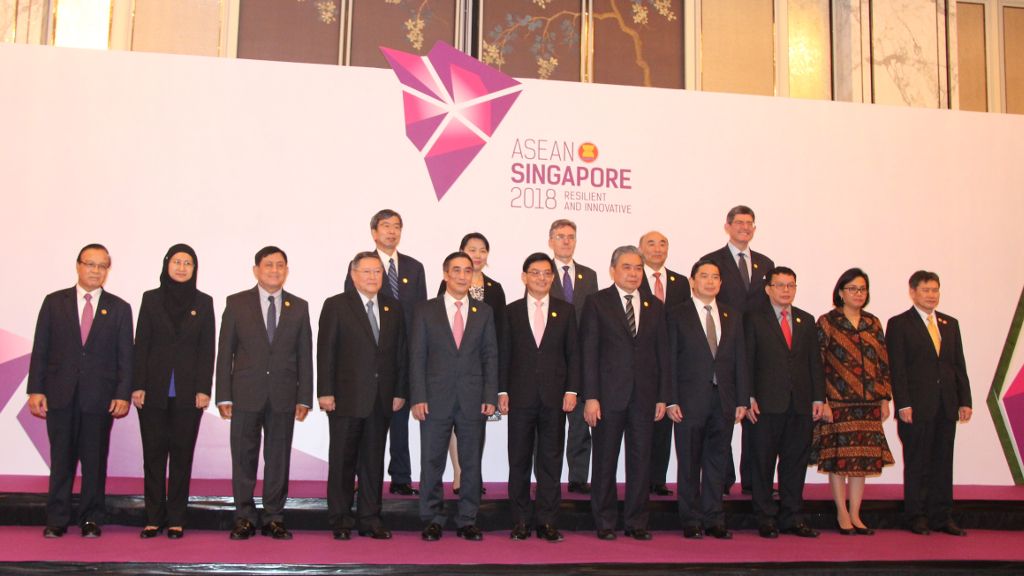ADB affirms support for infrastructure investment, financial inclusion at ASEAN meeting
ASEAN can take advantage of the current growth momentum to deepen reforms, while building fiscal space and financial resilience.

Asian Development Bank (ADB) President Takehiko Nakao participated in the 21st Association of Southeast Asian Nations (ASEAN) Finance Ministers’ and Central Bank Governors’ Meetings in Singapore on 5-6 April. In two speeches to the ministers and governors, Mr. Nakao discussed ADB’s economic outlook for ASEAN, the role ADB can play in helping the region invest in infrastructure, and how countries can harness the use of financial technology (fintech) to promote financial inclusion.
During his visit, Mr Nakao met with Deputy Prime Minister of Singapore Tharman Shanmugaratnam and Finance Minister of Singapore Heng Swee Keat. He also met with Finance Minister of Thailand Apisak Tantivorawong.
In his address to ASEAN finance ministers, Mr Nakao presented ADB’s economic forecast for the region, which shows that ASEAN growth will reach 5.2 percent in 2018.
“We see continued robust economic growth across ASEAN countries, supported by domestic demand as well as a synchronized recovery in global trade,” said Mr. Nakao. “ASEAN can take advantage of the current growth momentum to deepen reforms, while building fiscal space and financial resilience. Strengthening and deepening trade links with global and regional value chains could provide ASEAN a buffer against global uncertainties.”
Mr. Nakao emphasized the need for continued investment in infrastructure in ASEAN, including through public-private partnerships. Despite the rapid economic growth, ASEAN has a large infrastructure gap. ADB recently estimated that the region will need to invest USD 210 billion per year through 2030 to meet its infrastructure needs. Meanwhile, over 52 million people lack access to electricity, 61 million remain without safe drinking water, and 200 million do not have basic sanitation. More and better infrastructure will help ASEAN unleash the region’s economic potential and reduce poverty.
Mr. Nakao outlined ADB’s eight principles for supporting infrastructure investment: (i) alignment with national development strategy; (ii) economic feasibility, life-cycle costs, and debt sustainability; (iii) high level of technology and innovative solutions; (iv) social and environmental safeguards; (v) climate resilience and mitigation; (vi) good governance; (vii) jobs, capacity building, and gender mainstreaming; and (viii) catalyzing and mobilizing financial resources.
“ADB will increase financing throughout the ASEAN region, based on its eight principles for infrastructure investment,” said Mr. Nakao. “ADB will further bolster policy advice and capacity building for governments, enhance collaboration with the private sector and other partners, and strengthen cooperation with the ASEAN Infrastructure Fund (AIF).”
AIF is a dedicated fund established by ADB and ASEAN member nations to address the region's infrastructure development needs by mobilizing regional savings. As of end-2017, AIF has approved a total of USD 520 million for 9 projects, all cofinanced with ADB. Among the approved AIF projects are an ASEAN Highway Network transport project in Myanmar and three ASEAN Power Grid projects in Indonesia and Viet Nam.
In the second address to a joint meeting of ASEAN finance ministers and central bank governors, Mr. Nakao discussed how fintech can help promote financial inclusion in Asia. About two billion people in the world still do not have access to finance and half of them live in Asia and the Pacific.
By advancing innovations in financial services—such as smartphone-enabled financing, crowd-funding, and blockchain technology—fintech could greatly reduce transaction costs and improve access to financial services, particularly for underserved populations.
Mr. Nakao discussed three policies that harness the power of technology for financial inclusion. First, governments should ensure access to basic digital infrastructure. Second, policymakers need to provide an enabling environment for innovators and entrepreneurs. Third, policymakers should improve the regulatory environment, including protecting consumers against cybercrimes and fraud, and striking the right balance between innovations and financial stability.
ADB supports several fintech initiatives in the ASEAN region. Through its Mekong Business Initiative, cofinanced by the Australian government, ADB supports a number of technology start-ups in the Greater Mekong Subregion. Under this initiative, Kiu Global, a technology service company in Viet Nam, provides artificial intelligence-based credit scoring to commercial banks, improving access to credit for small and medium-sized enterprises. In 2017, ADB, Cantilan Bank, and Oradian, an IT company, launched a pilot cloud-based banking platform to enhance financial inclusion in Mindanao, Philippines.
To lead efforts to promote and further mainstream digital technology in ADB projects and programs, ADB established a new Digital Technology for Development Unit within the Sustainable Development and Climate Change Department in March 2018.










